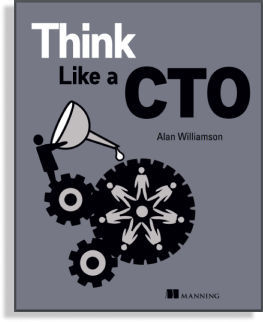I have just completed a 1,600 mile round trip from Orlando, Florida up to Richmond, Virginia. Up on a Friday, back down again on a Sunday, with each trip taking approximately 15hrs. While I have had my Tesla Model S P85D just over 2 years now, the longest journey I had done to date was Orlando to Key West with my son and cousin at the new year (which is a whole different story for another day).
One of my dreams is to put my hand in the Atlantic ocean, then drive over to the Pacific ocean and put my other hand in that – the great American road trip. So while I build up to that, I decided to do a run up and down to Richmond Virginia, to see how well things worked out.

Planning
There wasn’t much pre-planning that was required, aside from charging up phone and loading up my tablet with YouTube music videos and audiobooks. I have done this journey a number of times in a conventional gas powered vehicle, taking anywhere from 10hrs to 14hrs depending on traffic, with usually only 2 stops for filling up the tank.
An electric car is a different animal – I have a maximum range of 253 miles when fully charged and it takes just shy of 2 hrs to reach that level. So a quick back of the envelope calculation (800 / 253 = 4 charges required) it is looking like an extra 8 hrs to the journey.
That said, depending on your driving style (Vin Diesel vs. Mrs Daisy), air-con temperature, auto-pilot etc, your effective range mileage will vary. This all has to be factored in when planning your journey. Fortunately Tesla makes this a complete breeze.
Tesla provides a whole network of what they call Supercharger stations. These are dotted all over with more being added weekly. They are free to use for people that purchased their Tesla prior to 2017 (aka me!) and are approximately every 120-150 miles apart on the major highways.
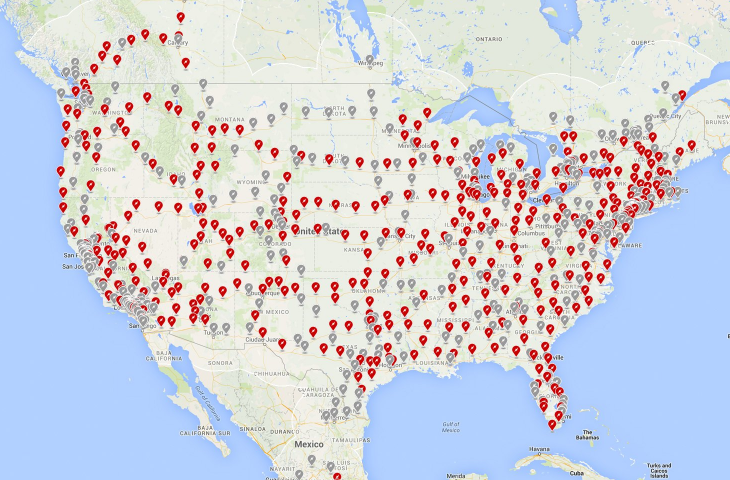
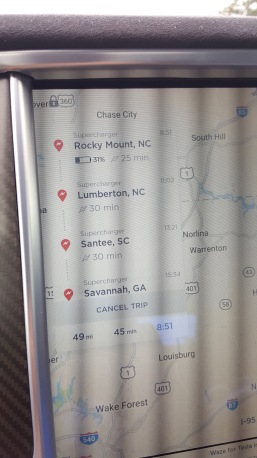
Using the in-car Google powered navigation, you tap in your destination and then the route is calculated to go via the necessary supercharger station to get you easily to your destination. There is a little magic to be sprinkled here.
So when charging a Tesla (or any battery for that matter), you can charge the battery quicker the emptier it is. In other words, you can throw more power at an empty battery and as it fills up, you reduce the power as it reaches 100%. Tesla can recharge your battery up to approximately 60% full, at a supercharger station, in approximately 20 minutes.
Instead of the route navigation assuming you are charging up to full battery each time, it only calculates how long it needs to charge you to get you to the next supercharger station. This is genius and saves a lot of time. In my instance, it calculated I needed to visit at least 5 supercharger stations, with only a 20-30 minute wait at each one.
Fantastic – no impatient waiting for hours at each stop.
Charging Stations
I took a small cooler case with water and grapes, filled up with ice and started on my journey. First stop was 2 hrs away at St Augustine, which was 5am by the time I reached there.
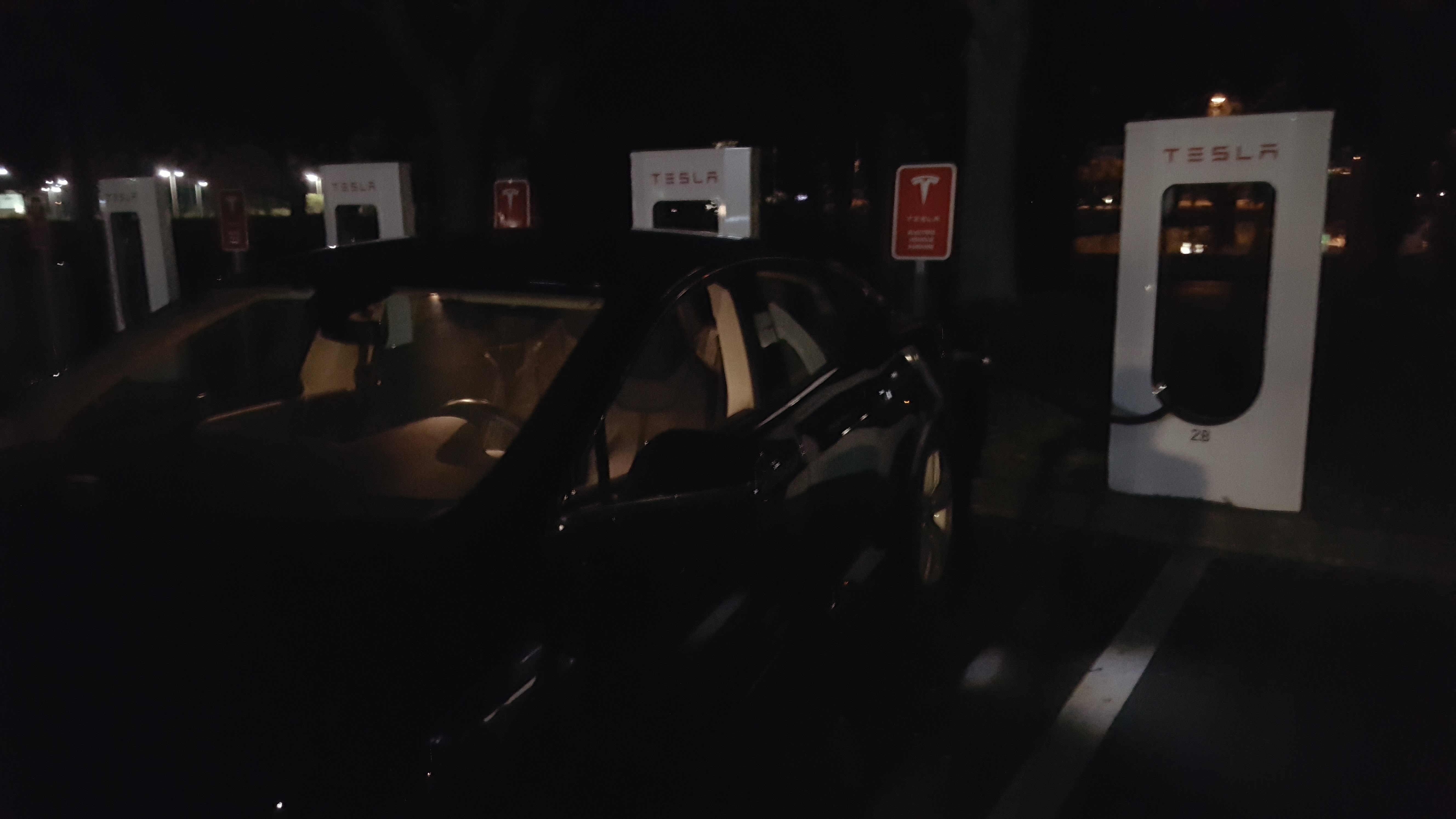
The location of the supercharger stations are usually within a mile from the main highway. Sometimes they can be a little further, Savannah airport one was 6 miles off the beaten track. They are usually tucked in the parking lot of a mall or a hotel. They are very easy to spot with their 2001 monolithic white rectangle standing guard over the parking bay.

You simply reverse in, get out, plug in, and you are now charging. Nothing needs to be done. The onboard computer knows you are plugged in and takes over all the know how. No credit-cards, no keying in, no buttons to press, it couldn’t be any easier.
I have not yet had the situation where I have had to wait for a bay to become available, though I suspect this will be more congested once the Model 3 hits the roads (though those users have to pay to charge, so that may keep the usage down a little).
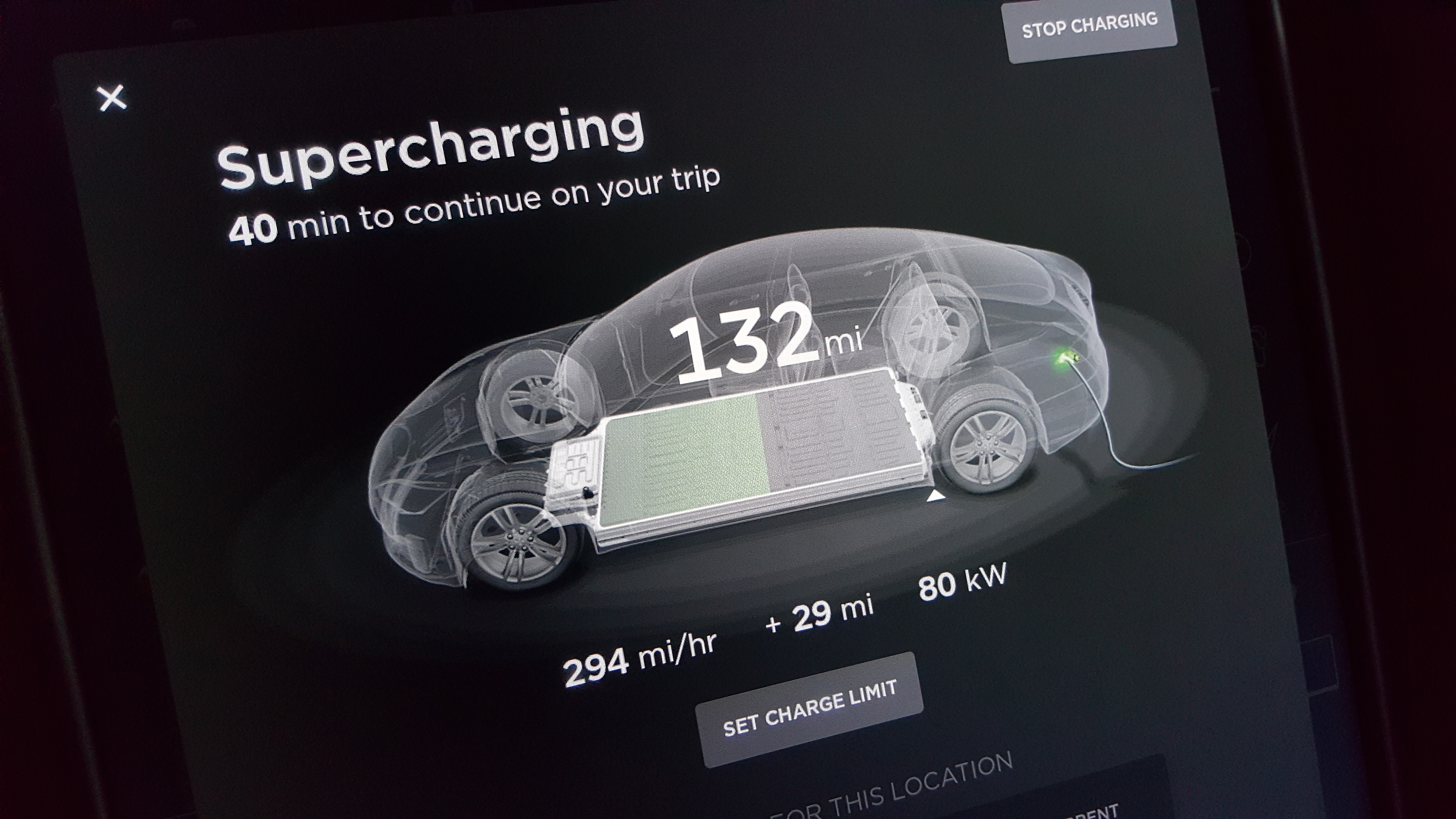
When the supercharging first starts it goes through a series of tests to see how much juice your battery can tolerate at once. To that end, it initially throws out some wild estimations as to how long it needs to charge, but give it 5 minutes and it will settle down to what the navigation system predicted.

Now, as noted before, this is not an exact science. So if your next charge point is say 120 miles away, it will give you at least a 170 miles in the tank, just incase. This buffer amount is generous and I frequently rolled into the next charging station with at least 50 miles on the clock.
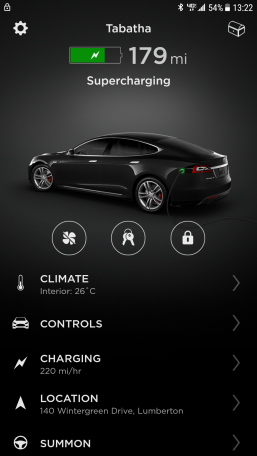
If I was brave, I could have disconnected the charging earlier than the dashboard prompted. I kept an eye on it and I noted I could have reduced my charge time by 5-10 minutes at some stops. But I wasn’t, so I didn’t.
At first I thought the charging would frustrate me. It turned out to be a small blessing. It broke down the journey into segments of maximum road time of 2.5hrs at a time. This afforded me the luxury of getting up and walking (I managed to still get in my 10k steps even with a 15hr road trip), restroom visit and general movement. One of the nice side benefits of stopping is talking with fellow Tesla drivers, trading stories and wishing them the best on their next stop. You play the game of looking at their tags and marveling at how far they have come. I met a number of far flung drivers and traded a few minutes of good will chat.
If you do take a walk away from the car, you can keep an eye on your mobile app that will tell you when the car has reached its charge. This feature cannot be overstated. It was extremely useful for the times I was sitting in Starbucks checking email to know when to pack up and head back.
I arrived more refreshed than I have historically on my gas-powered trips.
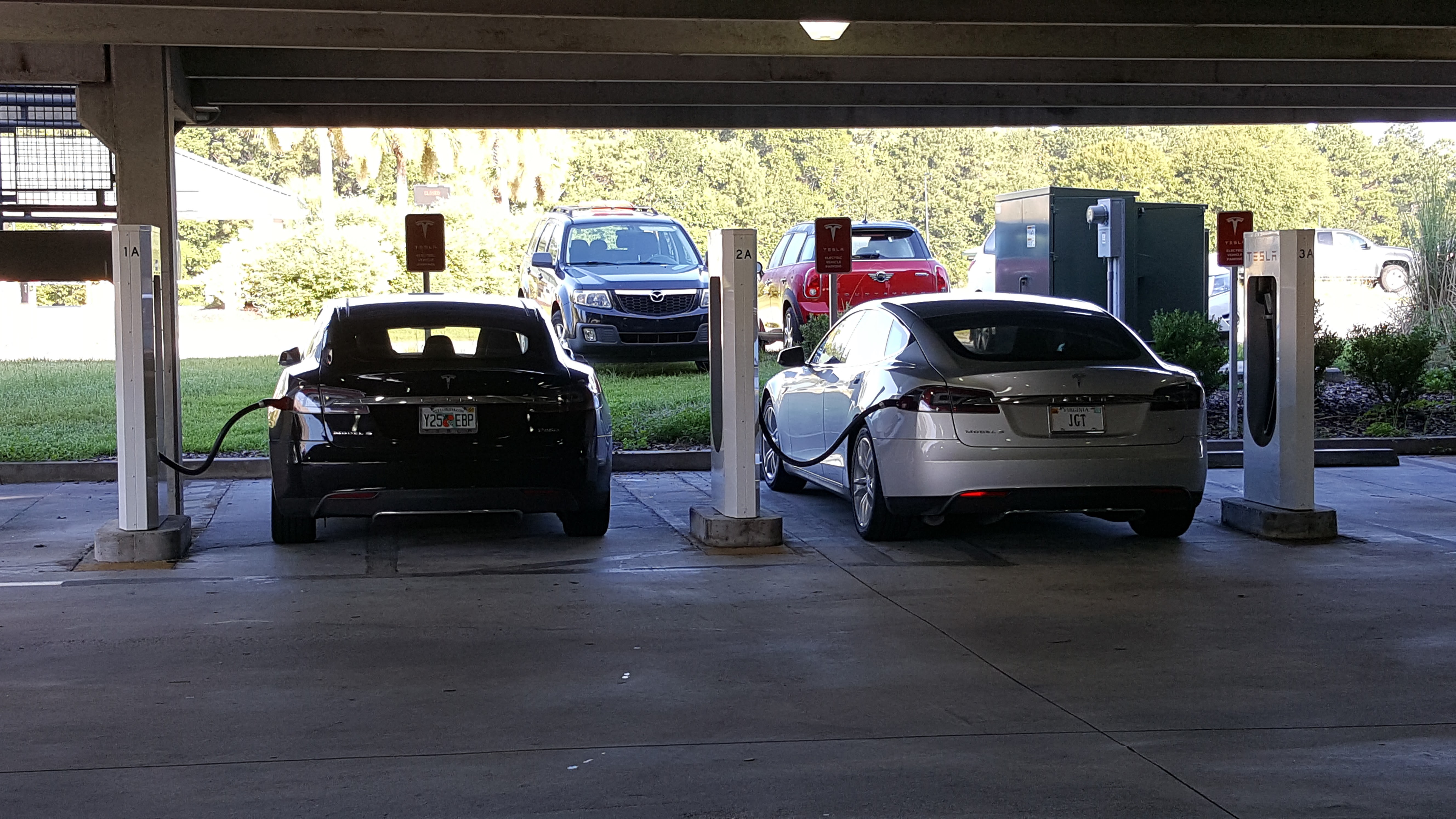
The drive
Enough of the charging, let us talk of the drive itself. This is no ordinary car you are driving. You are driving a car that every other automobile manufacturer is attempting to catch up to. Much has been talked about on the Auto-Pilot of Tesla and let me tell you on the open highway is where it excels.
 Adaptive Cruise Control
Adaptive Cruise Control
The first toy in the box is adaptive cruise control. This is where you set the speed you want to drive at, and then it will drive at that speed, adjusting the speed depending on the car in-front. In other words, if you set it at 70mph (and why would you ever set it any higher!) and the car in-front slows down to 20mph then you will slow down to that speed and then speed back up again when it is safe.
This works very well, especially in highway traffic when there is a tendency by hot-heads to cut in front of you. The car slows down accordingly, lets the hot-head in, and then speeds back up when the safe distance has been met.
There was a very heavy thunderstorm in Georgia, where visibility was next to nothing, I couldn’t even see the car in-front. However, my car could see (presumption using radar) and by using the adaptive cruise control, I could confidently be kept a safe distance from the car in-front, even though I couldn’t even eye-ball it.
I can’t tell you the amount of times this feature saved an accident, whether it was heavy rain, or assholes cutting into spaces they shouldn’t, or people in-front suddenly stepping on the brakes. While you do keep an eye on the road, you do have a tendency to daydream on long journeys. You know the state – you are looking at the road, but you aren’t really paying that much attention.
Another great usage of this feature is when traffic gets snarled up and you have to crawl forward at a snail’s pace. You don’t have to worry moving the car forward and then hitting the brakes. It does all this automatically. This was beautiful.
Auto-Steer
So the next step up from adaptive cruise control, is auto-pilot. This is where the car will do the steering and stay in the lane, automatically steering for you. At first it takes a little getting use to, allowing the car to steer itself. You sit there, feet off the pedals (because the car is controlling the speed), and hands off the steering wheel (because the car is steering), it takes a lot of faith that it is going to do what it needs to do!
Now, Tesla doesn’t want you to disengage completely. So it will prompt you to touch the steering wheel every so often. If you fail to do that, then it will disengage the auto-pilot and you will be punished by not being allowed to re-enable it until such times the car has come to a complete stop for a few minutes.
In reality, this just takes a little nudge. I found if I rested my elbow on the side of the door and rested my hand lightly on the steering wheel at the 10pm position (you know, the cool look) this was enough to fool the software into thinking that I was in control. Usually it was around every 1-2 minutes it would prompt me.
A nice feature that works very well is lane changing. If you decide you want to change lane, then you simply indicate your intention, and once the car has determined it is safe, it will change lane for you. This is extremely unnatural at first, but once you have faith, you will discover it is the best feature you could possibly ask for.
So a large part of my drive, was simply indicating to change lane. That was as much thinking as I had to do. Keeping up with traffic streams was a breeze.
Now the biggest benefit of letting the car control the speed, was the efficiency of power usage. Tesla has a number of displays, so you can see when you are pressing the accelerator (using more power). You do this far more than you realize, resulting in a lot of small surges that are not really necessary. Lot of battery wastage.
By letting the car do the speed, it will not be heavy on the right foot. I did a few experiments and discovered I could never drive as efficient as what it could. In a given 2hr segment this could mean up to an extra 20 miles in the tank.
Onboard Entertainment
A quick note to the on-board entertainment. The car is connected to the Internet under its own bandwidth (no piggy backing on your phone’s network). So in addition to the basic FM/AM radio, and USB playback, you have streaming from Tune-In/Streaming and of course bluetooth.
I listen to a lot of BBC content and it was nice to tune into BBC Radio 2 in the UK. For the times I didn’t do that, I would listen to a podcast (via the car), and after that, I would resort to listening to YouTube videos from my tablet via bluetooth.
Keeping an eye on the cops
So we all know the only reason people use Waze is to be notified of upcoming speed traps. As you may know, Tesla come with a full web browser. One of the coolest and most useful websites is https://tesla-waze.excelsis.com/
This is basically a view of Waze designed for the Tesla web browser, updating in real time for any upcoming hazards or police cars that happened to be parked at the side of the highway. I had this up all the time at the bottom of my screen, with the navigation on the top. Let’s just say, on the whole 1,600 mile journey, Waze never missed a single cop.
Conclusion
I arrived in Richmond, 15 minutes before the navigation route estimated some 15hrs ago. I hit traffic, I hit some roadworks, I hit weather. I was impressed.
I was describing the experience to a friend when I arrived, and I likened it to flying when you get the bonus of having the seat beside you free. In a plane you are cramped, and when there is no one in the seat next to you, you get to stretch out your legs into that space and feel human again.
When the car is in auto-pilot mode, your legs have the chance to move, to stretch. With no central console, you can easily stretch your legs into the passenger’s space. This little act of expanse can make all the difference in a long journey.
Overall, I was surprised at how painless and easy the journey was, even with the extra overhead of charging time. I arrived far more refreshed than I thought I would.
Driving a Tesla is an honor. Even after 2 years, each time I get in, I still feel a sense of excitement that I am driving something very special. The car receives software updates approximately once a month, further improving the experience. The car I bought in March 2015, is not the car I am driving in 2017.
I now have the confidence to start planning my coast-2-coast trip and take my trip around the USA, seeing this wonderful country, for $0 fuel cost. It would be a crime not to do the trip.

I loved my trip. It was an experience that I would not hesitate to do it again, choosing electric over flight.
My advice to you – if you get the chance, do it, you will fall in love with road trips all over again.

